Etude de bruit de fond induit par les muons dans l'expérience ...
Etude de bruit de fond induit par les muons dans l'expérience ...
Etude de bruit de fond induit par les muons dans l'expérience ...
You also want an ePaper? Increase the reach of your titles
YUMPU automatically turns print PDFs into web optimized ePapers that Google loves.
tel-00724955, version 1 - 23 Aug 2012<br />
Conclusion<br />
The sensitivity of a WIMP experiment is set by its rate of background events<br />
which are indistinguishable from WIMP candidates. Neutrons induced either<br />
directly by cosmic ray <strong>muons</strong> or indirectly by electromagnetic processes in the shower<br />
of a muon have to be consi<strong>de</strong>red as a limiting background source. The active muon<br />
shield, so called muon veto, of the EDELWEISS-II experiment is ma<strong>de</strong> to reject<br />
muon-induced background, by associating cosmic ray <strong>muons</strong> in the vicinity of the<br />
experiment with neutron recoil events in the bolometers.<br />
The EDELWEISS-II muon veto has already run for three years and is continuously<br />
taking data. Despite some discrepancies with the simulation, the analysis of<br />
the events yields a good <strong>de</strong>tection and i<strong>de</strong>ntification of muon candidates and their<br />
showers.<br />
Coinci<strong>de</strong>nces between the muon veto system and the bolometers are of great<br />
interest to reduce and un<strong>de</strong>rstand the muon-induced background. The first analysis<br />
of coinci<strong>de</strong>nces between the muon veto and the bolometer systems during Run 8 is<br />
successful. Although the <strong>de</strong>finition of the time of the event in the analysis B makes<br />
the coinci<strong>de</strong>nce events to be artificially centered at 25 ± 10 ms, the EDELWEISS-II<br />
experiment does i<strong>de</strong>ntify coinci<strong>de</strong>nces between bolometer events and muon candidates<br />
of the veto as a clear excess com<strong>par</strong>ed to the expected acci<strong>de</strong>ntal rate. The<br />
coinci<strong>de</strong>nce rates are<br />
for ER < 250 keV, Γ Run8<br />
coinc = 0.043 ± 0.015 events·(kg·d) −1<br />
for ER ≥ 250 keV, Γ Run8<br />
coinc = 0.09 ± 0.02 events·(kg·d) −1<br />
(6.20)<br />
(6.21)<br />
which can be com<strong>par</strong>ed and are in agreement with the simulated rate at low energy.<br />
However, the analysis was not as complete as it could have been, since there<br />
was no overall clock on the experiment. Since each data acquisition had its own<br />
in<strong>de</strong>pen<strong>de</strong>nt clock, <strong>de</strong>fining the time of the different sets of bolometers has been<br />
difficult, and periods have been removed regard<strong>les</strong>s of the quality of the data. The<br />
lack of one global clock for the entire system was a huge problem during Run 8.<br />
For Run 10, a new <strong>de</strong>vice to dispatch a unique time for all sub-systems was<br />
installed. However, in contrast to Run 8, there was no calibrated data available<br />
yet for Run 10. The second analysis is based on the “ntp” fi<strong>les</strong>, which are the<br />
online pre-processed data, usually used for the monitoring. Using the ntp fi<strong>les</strong>,<br />
the rate of bolometer was 10 times higher and the coinci<strong>de</strong>nces with muon veto,<br />
if any, completely overwhelmed in background. To perform the analysis, a drastic<br />
cut has been applied: only events with EH > 30 keV and EI > 30 keV are kept.<br />
The advantage of the cut is that it removes all low ionization and low heat events,<br />
without applying a complex bolometer period analysis as the one which has been<br />
performed for the analysis of Run 8. The disadvantage is that it will also cut any<br />
low Q, low ER muon-induced neutron-like events, as the ones found in Run 8.<br />
The analysis of the bolometers with the ntp is not meant to be a full standard<br />
reference analysis, but it allows to have a first look into the bolometer data and to<br />
further look for coinci<strong>de</strong>nces with the muon veto. And the analysis of coinci<strong>de</strong>nces<br />
137<br />
6


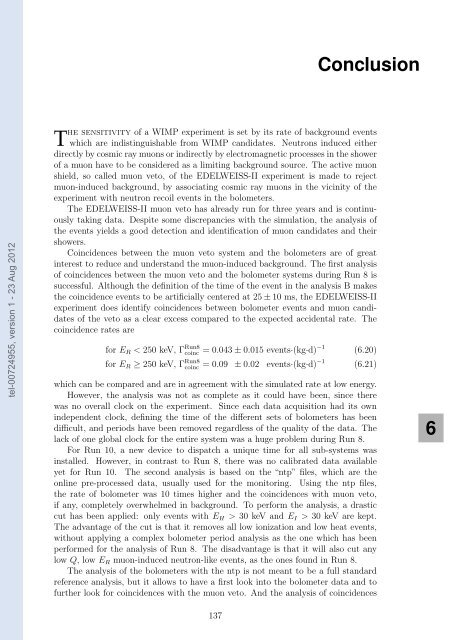

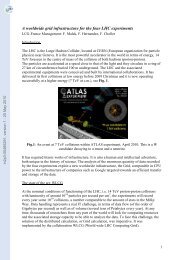

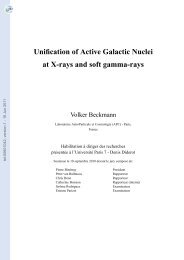

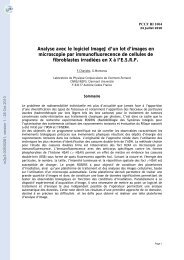
![[in2p3-00383985, v1] NUCLEAR PHYSICS at GANIL ... - HAL - IN2P3](https://img.yumpu.com/19016755/1/185x260/in2p3-00383985-v1-nuclear-physics-at-ganil-hal-in2p3.jpg?quality=85)
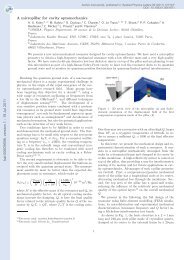
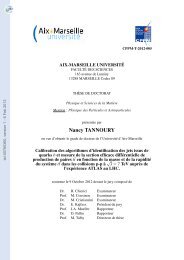
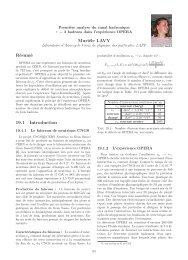
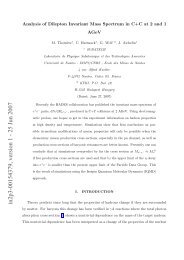
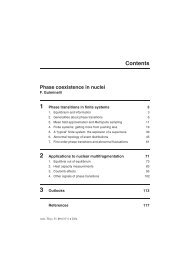
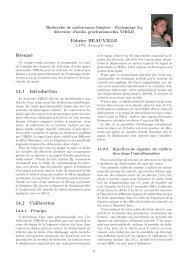
![[tel-00752304, v1] Pions réels et virtuels dans les noyaux](https://img.yumpu.com/19016523/1/184x260/tel-00752304-v1-pions-reels-et-virtuels-dans-les-noyaux.jpg?quality=85)